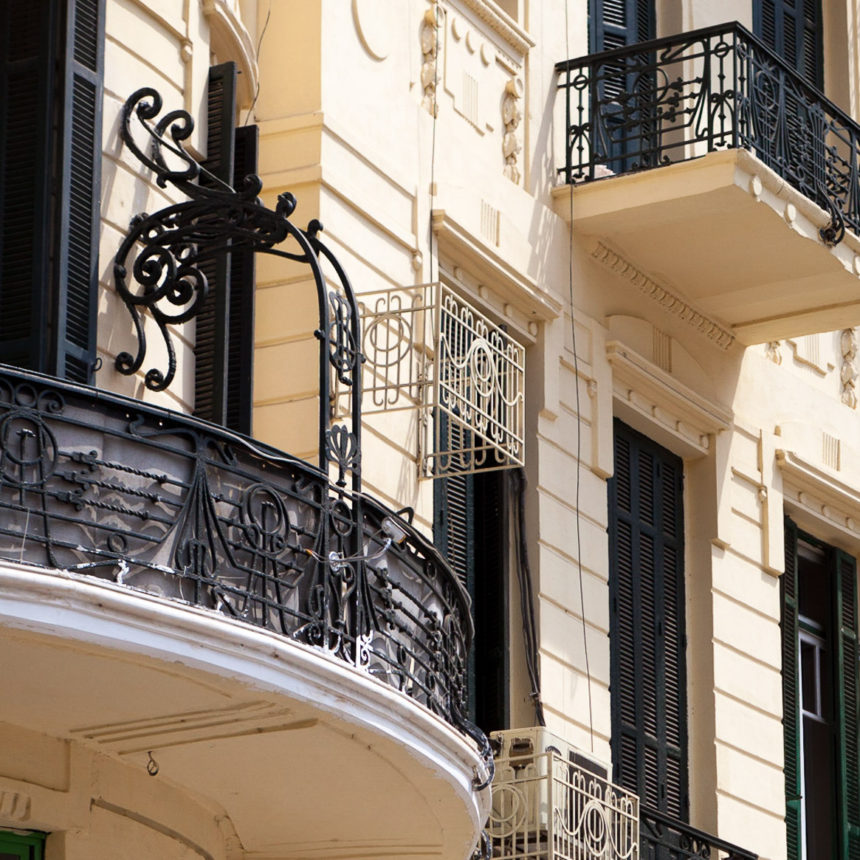One autumn Friday morning, I dove into Egypt’s urban legends joining a newly inaugurated walking tour of downtown Cairo set in place by a development company called Al Ismaleya. From Art-Deco icons to historical cinemas, we set off to discover the stories woven by the area’s stimulating streets.
We are standing at the foot of a building set in a crossroad where amber French-style villas craft an ambiance that could deceive our minds. We could be in Paris; we could also be in Madrid, but the statue at the center of the square exudes Arab iconography and suddenly brings our mind back to Cairo. We are at the epicenter of midan Talat Harb, and the tour is about to begin.
Revamped, repainted, and reinventing urban legends for the travelling minds, the buildings in downtown Cairo have been renewed by Ismaelia, somehow reflecting a spirit of revival that reigns the area. We start off at Café Groppi, an icon of art-deco architecture in the victorious city. Built in 1924, the chocolatier’s imbricate mosaics and curving façade came to replace what previously was the villa of Ali Basha Mubarak.
This was a residential and cultural heart of downtown Cairo. All around us, early 20th century villas and family palaces bear witness to Cairo’s golden age, when families such as Sednaoui would rest in their luscious private gardens, which were later replaced by apartment buildings.
By the end of the road, symbolic and unforgettable, Tahrir square sparks a renewed flare. The square was formerly known as Khedive Ismail square, in honor of the ruler who gave Cairo a Parisian flavor in 1860’s, through the work of talents such as Baron Haussman, known for giving Paris its modern configuration. As we walk past Café Riche, we move on to the Automobile Club, an originally neo-Islamic design by Italian architect Gaston Rossi which was remodeled in 2002, when its façade was replaced for a Neo-Classical flavor.
It’s Friday morning and the sun paints a mild stroke over these now amber buildings. As we stand in front to the old Palace of Said Halim, we are taken aback by a 1920 art-deco exemplary whose iron door deliciously blends geometric patterns with pharaonic symbols such as the zig-zag and the lotus flower.
The mixture of neo-baroque, art-deco, and Islamic symbols mixed with the tranquil pace of a Friday morning walk feels like strolling across an open-air museum, only interrupted by the whistle of bread sellers’ bicycles.
The sun begins to itch as we reach Abdin Street, the cultural hub where cinemas and cafés used to stand. We approach the art-deco icon Radio Cinema, designed by Italian architect Gaston Rossi in the 1930s. An exact replica of New York’s Radio City Music Hall, the impactful studio cinema used to host Bassem Youssef’s Al Bernameg show, which became very popular with Egyptians in the aftermath of the 2011 revolt. We enter the cinema and it feels like a trip in time: as the echo of our guide’s voice reverberates through the room, 800 red velvet chairs silently stand around a stage framed by golden art deco lamps.
It’s almost midday and the Qur’an reverberates from the mosque, anticipating the call to prayer as an Armenian church stands by its side. Between the buildings, a blossoming tree filled with orange flowers stands as a beautiful metaphor. Outside, the church walls bear witness to the revolution, coloring the sidewalk with striking graffiti.
We enter the Armenian Catholic church, one of the three major Christian communities in Egypt, along with the Italian and Greek communities. Since in 1952, the Armenian community established itself as the largest group. Modest and decorated with astounding colorful stained glass, the church was built in 1926 by Garovalian. The story of its building is as beautiful as metaphorical: an Orthodox Christan, Garovalian built this Catholic Church for the community, even though he was to use an Orthodox church, built in turn by a Catholic architect.
We reach the Stock Exchange building, a neo-classical example whose large columns reflect the Greco-Roman influence. The center of economic activity, the Borsa was closed between 1984 and 1994. Its renewal turned the surrounding street into a pedestrian haven dotted by colorful chairs and shisha pipes who became popular after the 25 January uprising, awaiting students and businessmen alike. Once we enter the building, the beautifully painted dome crowning its ceiling catches our eye.
A few steps away on Alawi Street, we bump into a neo-Islamic gem designed by Antonio Lasciac, who made a collage with mamelouc decorations where European balconies perch. Now belonging to the Central Bank, the building was the headquarters of the Italian insurance company Assicurazioni Generali di Trieste, a name which we can still see engraved on the wall.
We walk past the colossal Shorbagui building, a 7-floor Gothic jewel whose dark walls contrast the surrounding amber constructions, and stop at the Sha’ar Hashamayim synagogue on Adly Pasha Street, another symbol of Egypt’s history of coexistence. Designed by Edouard Matasek, the building’s art Nouveau style stands out. As we begin to get hungry, we look across the street and spot the beautifully decorated restaurant Aish and Malh.
As we stop for lunch, we meet Mr. Dongol, the tireless guardian of the Kodak building now being repaired. A green galabeya perches on his small, slim body and a woolen striped hat frames his sparkling eyes. As he sits with a firm grip on his stick, next to a scaffolding on a wooden chair, he quickly strikes a conversation with us. He tells us he is 95, he speaks 5 languages, and for some reason, doesn’t stop saying “mangareya” every other word. His gracious expressions and timid smile are the beautiful end of a morning full of stimuli.
This article was originally published in Cairoscene.







Leave a Reply